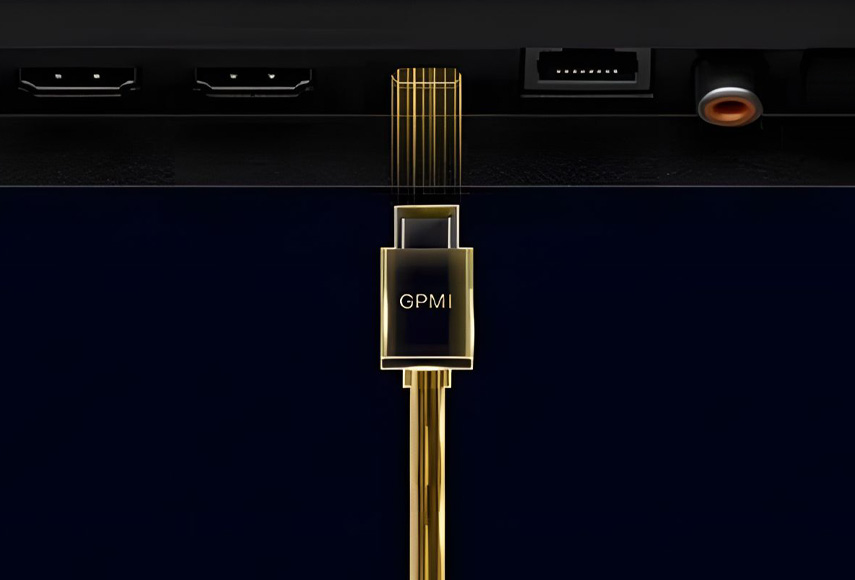
The race to define the future of device connectivity just got a lot more interesting. China has unveiled its General Purpose Media Interface (GPMI), a new cable standard that’s turning heads with its jaw-dropping specs. Boasting up to 192 Gbps of bandwidth and 480W of power delivery through a single cable, GPMI isn’t just competing with Western standards like HDMI, DisplayPort, and USB-C—it’s aiming to redefine how our devices talk to each other. Backed by over 50 Chinese tech giants, this standard could shift the balance of power in the global tech landscape and challenge the dominance of Western interfaces.

How GPMI Came to Be – Origins and development
GPMI didn’t appear out of nowhere. It’s the brainchild of the Shenzhen 8K Ultra High Definition Video Industry Collaboration Alliance, a powerhouse group featuring heavyweights like Huawei, TCL, Hisense, and Skyworth. Since 2019, this coalition has been hard at work designing a next-gen connectivity solution to meet the demands of tomorrow’s tech.

Fast-forward to December 2024, and GPMI hit a major milestone when it was greenlit by the USB organization, earning an official SVID (0xFF10) for seamless integration with USB-C systems. By February 2025, the Alliance rolled out a comprehensive set of standards under the “General Purpose Multimedia Interface Specification,” cementing China’s vision for a unified, cutting-edge approach to multimedia connectivity.
What Makes GPMI Stand Out?
GPMI comes in two flavors, each packing a serious punch compared to what’s out there today. The GPMI Type-C version plays nice with existing USB-C setups, delivering 96 Gbps of bandwidth—more than double the 40 Gbps ceiling of USB4 or Thunderbolt 4—and up to 240W of power, matching the best USB-C can offer.
Then there’s the beefier GPMI Type-B connector, a proprietary design that cranks things up to 192 Gbps (four times HDMI 2.1’s limit) and a whopping 480W of power—enough to juice up high-end gaming laptops. Whether you’re streaming 8K video or powering a workstation, this thing means business.
What sets GPMI apart is its all-in-one approach. It handles video, audio, data, and power over a single cable, cutting down on the tangle of cords we’re all too familiar with. Plus, it’s bidirectional, so data flows both ways effortlessly. Need to control your phone’s apps from your TV remote? GPMI’s got you covered.
It also swaps out HDCP for a homegrown content protection system called ADCP, built on Chinese security algorithms (SM3 and SM4). This not only speeds up connections but also wakes devices in a fraction of the time compared to older standards.
Why It Matters for You
Imagine plugging in one cable to power your laptop, connect to a 4K monitor, and stream high-def content—all at once. That’s the kind of simplicity GPMI brings to the table. For gamers, it means a single cord to hook up a rig to an external display without sacrificing performance. For home theater buffs, it’s a cleaner setup with fewer cables snaking around.
With 8K content on the horizon (which demands way more data than 4K), GPMI’s massive bandwidth ensures it’s ready for the future. It even supports daisy-chaining, so you can link multiple devices—like speakers, consoles, or digital signage—with one cable, slashing setup costs and complexity.
One cool trick? GPMI’s reverse control feature lets you use your TV remote to navigate mobile games or apps on the big screen, blending your phone and TV into one seamless experience.
How It Measures Up
Here’s a quick look at how GPMI compares to the standards you’re probably using now:
| Standard | Bandwidth | Power Delivery | What It’s Known For |
|---|---|---|---|
| HDMI 2.1 TMDS | 18 Gbps | None | The go-to for TVs and monitors |
| HDMI 2.1 FRL | 48 Gbps | None | Supports 8K at 60Hz |
| DisplayPort 2.1 | 80 Gbps | 240W | Great for PC monitors, up to 16K |
| Thunderbolt 4 | 40 Gbps | 100W | Speedy and versatile for laptops |
| USB4 | 40 Gbps | 240W | Universal, works with almost everything |
| GPMI Type-C | 96 Gbps | 240W | USB-C friendly, doubles USB4’s bandwidth |
| GPMI Type-B | 192 Gbps | 480W | Unmatched speed, powers heavy-duty devices |
GPMI Type-C already outpaces DisplayPort 2.1’s 80 Gbps while keeping USB-C compatibility. The Type-B version? It’s in a league of its own, doubling DisplayPort’s bandwidth and delivering twice the power. For anyone juggling high-res displays and power-hungry gadgets, that’s a game-changer.
What’s Next for GPMI?
GPMI’s specs are impressive, but it’s not a slam dunk yet. As a Chinese-led standard, it might face skepticism in the U.S. and Europe, where HDMI and USB-C are household names. Geopolitics could play a role too, with Western markets potentially slow to embrace a standard tied to Chinese tech giants.
Still, GPMI has a lot going for it. Its Type-C version fits right into the USB-C ecosystem, which could ease its way into laptops, phones, and TVs. The promise of fewer cables and less e-waste is a universal win, and if major brands start adopting it, GPMI could catch on fast.
The Bigger Picture
Whether GPMI becomes a global standard or stays a regional player, one thing’s clear: China’s flexing its tech muscle. This isn’t just about cables—it’s about who gets to shape the future of how our devices connect. For U.S. consumers, GPMI could mean simpler setups and better performance down the line, but it’ll take time to see if it can win over the world.
What do you think—could GPMI be the next big thing in your tech setup?





